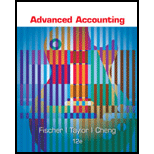
Concept explainers
Business combination:
Business combination refers to the combining of one or more business organizations in a single entity. The business combination leads to the formation of combined financial statements. After business combination, the entities having separate control merges into one having control over all the assets and liabilities. Merging and acquisition are types of business combinations.
Consolidated financial statements:
The consolidated financial statements refer to the combined financial statements of the entities which are prepared at the year-end. The consolidated financial statements are prepared when one organization is either acquired by the other entity or two organizations merged to form the new entity. The consolidated financial statements serve the purpose of both the entities about financial information.
Value analysis:
The value analysis in a business combination is an essential part of determining the worth of the acquired entity. The
:
Prepare the value analysis and the determination and distribution of excess schedule for the investment in Company S.
Want to see the full answer?
Check out a sample textbook solution
Chapter 4 Solutions
Advanced Accounting
- Mission Company is preparing its annual profit plan. As part of its analysis of the profitability of individual products, the controller estimates the amount of overhead that should be allocated to the individual product lines from the information provided below. (CMA adapted) Wall Mirrors Specialty Windows Units produced 40 20 Material moves per product line 5 15 Direct labor-hours per product line 200 300 Budgeted material handling costs: $50,000 Under a traditional costing system that allocates overhead on the basis of direct labor-hours, the materials handling costs allocated to one unit of Specialty Windows would be: Multiple Choice $2,000. $500. $5,000. $1,500.arrow_forwardWhat is the materials quantity variance?arrow_forwardWhen does the matching principle require modification in start-up companies? A. During normal operations B. Only after becoming profitable C. When substantial costs precede any revenue generation D. For tax reporting onlyarrow_forward
- If 200 million shares of common stock are issued with a par value of $2 and additional paid-in capital is $750 million, the total par value of the issued shares is__. A) $300 million B) $950 million C) $400 million D) $1.2 billion solve this Accounting problemarrow_forwardBanc Corporation Trust is considering either a bank-wide overhead rate or department overhead rates to allocate $390,000 of indirect costs. The bank-wide rate could be based on either direct labor-hours (DLH) or the number of loans processed. The departmental rates would be based on direct labor-hours for Consumer Loans and a dual rate based on direct labor-hours and the number of loans processed for Commercial Loans. The following information was gathered for the upcoming period: Department DLH Loans Processed Direct Costs Consumer 15,000 600 $ 250,000 Commercial 6,000 400 $ 150,000 If Banc Corporation Trust uses a bank-wide rate based on the number of loans processed, what would be the total costs for the Consumer Department? Multiple Choice $228,000 $250,000 $484,000 $540,000arrow_forwardCan you solve this financial accounting problem using appropriate financial principles?arrow_forward
- I need guidance with this general accounting problem using the right accounting principles.arrow_forwardCan you help me solve this general accounting problem with the correct methodology?arrow_forwardI am searching for the correct answer to this general accounting problem with proper accounting rules.arrow_forward

 AccountingAccountingISBN:9781337272094Author:WARREN, Carl S., Reeve, James M., Duchac, Jonathan E.Publisher:Cengage Learning,
AccountingAccountingISBN:9781337272094Author:WARREN, Carl S., Reeve, James M., Duchac, Jonathan E.Publisher:Cengage Learning, Accounting Information SystemsAccountingISBN:9781337619202Author:Hall, James A.Publisher:Cengage Learning,
Accounting Information SystemsAccountingISBN:9781337619202Author:Hall, James A.Publisher:Cengage Learning, Horngren's Cost Accounting: A Managerial Emphasis...AccountingISBN:9780134475585Author:Srikant M. Datar, Madhav V. RajanPublisher:PEARSON
Horngren's Cost Accounting: A Managerial Emphasis...AccountingISBN:9780134475585Author:Srikant M. Datar, Madhav V. RajanPublisher:PEARSON Intermediate AccountingAccountingISBN:9781259722660Author:J. David Spiceland, Mark W. Nelson, Wayne M ThomasPublisher:McGraw-Hill Education
Intermediate AccountingAccountingISBN:9781259722660Author:J. David Spiceland, Mark W. Nelson, Wayne M ThomasPublisher:McGraw-Hill Education Financial and Managerial AccountingAccountingISBN:9781259726705Author:John J Wild, Ken W. Shaw, Barbara Chiappetta Fundamental Accounting PrinciplesPublisher:McGraw-Hill Education
Financial and Managerial AccountingAccountingISBN:9781259726705Author:John J Wild, Ken W. Shaw, Barbara Chiappetta Fundamental Accounting PrinciplesPublisher:McGraw-Hill Education





